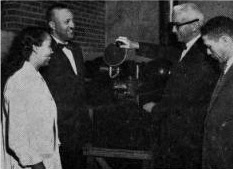 |
| Dr. Gladys Royal (left), Dr. W. E. Reed (left center), R. L. Satoera (right center) and Dr. George Royal (right), with x-ray equipment, North Carolina A&T College, 1961 By THE AGRICULTURAL AND TECHNICAL, COLLEGE, GREENSBORO, N. C. - THE A&T COLLEGE REGISTER, VOLUME XXXII, No. 8 , FRIDAY, JANUARY 13, 1961, Public Domain, https://commons.wikimedia.org/w/index.php?curid=42353373 |
Topics: African Americans, Diversity in Science, Biochemistry, Nanotechnology, Women in Science
See: Biochemistry and structural DNA nanotechnology: an evolving symbiotic relationship.
Gladys W. Royal (August 29, 1926 – November 9, 2002) is one of a small number of early African-American biochemists. Part of one of the few African-American husband-and-wife teams in science, Gladys worked with George C. Royal on research supported by the United States Atomic Energy Commission. She later worked for many years as principal biochemist at the Cooperative State Research Service of the U.S. Department of Agriculture. Royal was also active in the civil rights movement in Greensboro, North Carolina.
Royal was born Gladys Geraldine Williams on August 29, 1926, in Dallas, Texas. She graduated from Dillard University with a B.Sc. at the age of 18 in 1944. She married George C. Royal in 1947.
Royal accompanied her husband to Tuskegee, Alabama, where he taught microbiology in 1947-1948, to Ohio State University and Ohio Agricultural Experiment Station, where he was a research assistant from 1948 to 1952, and to North Carolina Agricultural and Technical College in Greensboro where he became an assistant professor of Bacteriology in 1952. At Tuskegee and Ohio State she took classes; by 1953, she was sufficiently qualified to become a professor of chemistry at North Carolina Agricultural and Technical College in Greensboro.
In 1954, Royal received her M.Sc. in organic chemistry from Tuskegee. She had also taken classes at the University of Wisconsin and at Ohio State University, from which she received her Ph.D. in 1954. Her thesis, The Influence of Rations Containing Sodium Acetate and Sodium Propionate on the Composition of Tissues From Feeder Lambs, involved experimental work in flavor chemistry, testing the effects of various feed regimens on the taste of meat.
In the late 1950s and early 1960s, the Royals collaborated on important research including that funded by the United States Atomic Energy Commission involving bone marrow transplants to treat radiation overdoses. Their work had direct relevance to cancer treatment, which used high doses of radiation and could cause tissue damage. It also reflected Cold war fears of possible nuclear attack.
African-American husband-and-wife teams in science were extremely rare in the early and mid-20th century due to the social, educational and economic climate regarding African Americans in the United States.
The Royals had six children: George Calvin Royal III, Geraldine Gynnette Royal, Guericke Christopher Royal, jazz musician Gregory Charles Royal, Michelle Renee McNear, and Eric Marcus Royal.
Source: Wikipedia/Gladys_W._Royal
Comments